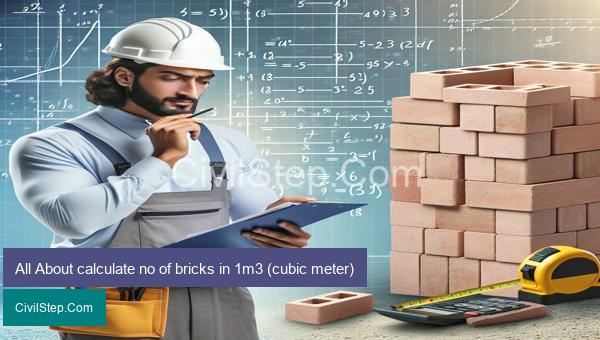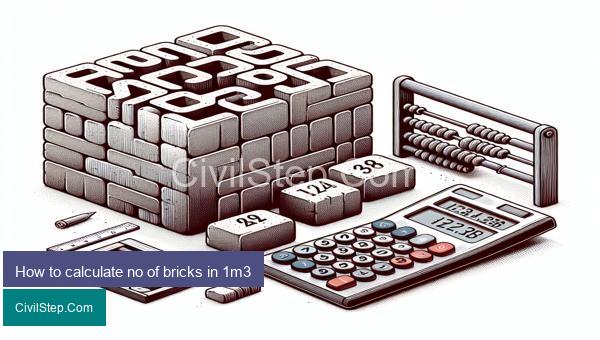
Bricks have been used in construction for centuries and continue to be a fundamental building material in modern times. However, the calculation of the number of bricks required for a particular project can be a daunting task for many. Whether you are a novice in the field of construction or a seasoned professional, accurately determining the total number of bricks needed for a specific volume, such as 1m3, is crucial to avoid wastage and ensure cost-effectiveness. In this article, we will delve into all the essential information and techniques involved in calculating the number of bricks required in 1m3, providing valuable insights and useful tips for any construction project.
How to calculate no of bricks in 1m3 (cubic meter)

Calculating the number of bricks in 1m3 (cubic meter) is an essential skill for civil engineers. This calculation is important for estimating the quantity of materials needed for a construction project, such as building a wall or a house. Knowing the number of bricks required can also help in determining the cost of the project.
Here is a step-by-step guide on how to calculate the number of bricks in 1m3:
Step 1: Determine the size of the brick
The first step is to determine the size of the brick. Bricks come in different sizes, and the most commonly used size is 9 inches by 4.5 inches by 3 inches (length x width x height). This size is also known as a “standard brick”. However, it is essential to check with the manufacturer or supplier of the bricks to ensure that the size is accurate.
Step 2: Convert the size to meters
Next, convert the brick size to meters. This will make the calculation easier since we are working with cubic meters. Using the standard brick size mentioned above, we can convert it to 0.2286m by 0.1143m by 0.0762m (length x width x height). The volume of one standard brick is 0.0017692572m3 (0.2286 x 0.1143 x 0.0762).
Step 3: Calculate the volume of 1m3
To calculate the volume of 1m3, we need to multiply the three dimensions of 1m3, which are 1m x 1m x 1m. This will give us the volume of 1 cubic meter, which is 1m3.
Step 4: Divide the volume of 1m3 by the volume of one brick
Now, divide the volume of 1m3 by the volume of one brick. This will give us the number of bricks that can fit in 1m3. Using the standard brick size, we can calculate it as follows:
1m3/0.0017692572m3 = 565.4 bricks.
Hence, 565.4 bricks can fit in 1m3.
Step 5: Consider the mortar joint
The above calculation does not take into account the space occupied by the mortar joint. Mortar joint is the filling material between bricks that holds them together. Depending on the brickwork, the average thickness of the mortar joint can vary from 10mm to 20mm. For our calculation, we will consider a 10mm thick mortar joint.
To compensate for the mortar joint, we need to reduce the total number of bricks calculated by 10%. Hence, the final number of bricks in 1m3 is:
565.4 – 10% of 565.4 = 508.86 bricks.
Therefore, considering a 10mm mortar joint, we can fit 508.86 bricks in 1m3.
Step 6: Round up the number
Since we cannot have a fractional number of bricks, we need to round up the calculated result to the nearest whole number. In this case, we will round it up to 509 bricks.
Hence, the final result is 509 bricks in 1m3, considering a 10mm mortar joint and using the standard brick size mentioned above.
In conclusion, calculating the number of bricks in
How to calculate no of bricks in 1m3

Calculating the number of bricks needed for a construction project is an essential skill for civil engineers. Bricks are a common building material used in the construction of walls, foundations, and other structures. Having a precise estimate of the number of bricks required for a project helps in budget planning and managing construction costs.
Here are the steps to calculate the number of bricks in 1m3:
Step 1: Determine the size of the brick
Bricks come in different sizes and shapes. Before calculating the number of bricks needed, it is crucial to determine the dimensions of the bricks that will be used for the construction project. Standard brick sizes vary in different regions, but the typical sizes are 9 x 4 1/2 x 2 1/2 inches or 230 x 115 x 65 mm.
Step 2: Calculate the volume of one brick or Vb
To calculate the volume of one brick, use the formula V= L x W x H, where L represents the length, W represents the width, and H represents the height of the brick. For example, if a brick measures 9 x 4 1/2 x 2 1/2 inches, its volume would be:
V= 9 x 4.5 x 2.5
V= 101.25 cubic inches
Step 3: Calculate the volume of 1m3 or Vm
1m3 (cubic meter) is equal to 1,000,000 cubic millimeters. Therefore, to calculate the volume of 1m3, we can multiply 1,000,000 by the volume of one brick in cubic inches. Continuing with our example, we can calculate the volume of 1m3 as:
Vm = 1,000,000 x 101.25
Vm= 101,250,000 cubic millimeters
Step 4: Calculate the number of bricks in 1m3
The number of bricks in 1m3 can be calculated by dividing the volume of 1m3 (Vm) by the volume of one brick (Vb). In our example, we can calculate the number of bricks in 1m3 as:
Number of bricks = Vm/Vb
Number of bricks = 101,250,000/ 101.25
Number of bricks = 1,000,000
This means that 1m3 of space requires one million standard-sized bricks to fill it.
Step 5: Adjust for wastage and bonding
When building walls, there is a certain amount of wastage due to cutting bricks for corners, lintels, and other architectural features. Also, the bricks are usually laid in a staggered pattern for better strength and stability, known as “bonding.” Therefore, to calculate the actual number of bricks needed for construction, it is essential to account for wastage and bonding. Engineers usually add an additional 5-10% to the final number to account for these factors.
In conclusion, calculating the number of bricks in 1m3 requires determining the size of the bricks, calculating the volume of one brick, calculating the volume of 1m3, and dividing by the volume of one brick. It is also essential to adjust for wastage and bonding to get an accurate estimate of the number of bricks needed for a construction project. By following these steps, civil engineers can accurately calculate the number of bricks required
How many bricks in 1 cubic meter

The number of bricks in 1 cubic meter can vary depending on the size and shape of the bricks. However, a standard 8-inch by 4-inch by 2.25-inch brick can be used as a reference to estimate the number of bricks in 1 cubic meter.
To calculate the number of bricks in 1 cubic meter, we must first determine the volume of a single brick. The volume of a brick can be calculated by multiplying its length, width, and height. In the case of a standard brick, the volume would be:
V = 8 inches x 4 inches x 2.25 inches = 72 cubic inches
Since 1 cubic meter is equivalent to 35.3147 cubic feet or 1,000,000 cubic inches, we can now calculate the number of bricks in 1 cubic meter by dividing the volume of a cubic meter by the volume of a single brick.
Number of bricks = 1,000,000 cubic inches / 72 cubic inches = 13,888.89 bricks
It is important to note that this calculation is only an estimate, as the exact number of bricks may vary due to factors such as brick size, mortar joint thickness, and manufacturing differences.
Moreover, if different types of bricks with varying sizes are used, the number of bricks in 1 cubic meter will also vary accordingly. For example, larger or longer bricks would result in a lower number of bricks per cubic meter, while smaller or thinner bricks would increase the number of bricks per cubic meter.
In conclusion, the estimated number of bricks in 1 cubic meter would be around 13,888, but it is recommended to consult with a structural engineer or brick supplier for a more accurate count based on the specific type of bricks being used.
Conclusion
In conclusion, understanding how to calculate the number of bricks in 1m3 is essential for any construction project. By following the simple steps outlined in this article, one can accurately determine the quantity of bricks needed, saving time and money. It is important to keep in mind the different factors that may affect the calculation, such as the size and type of brick. Additionally, being aware of the standard dimensions of bricks can assist in making more precise estimations. With this knowledge, one can confidently plan and execute their project, ensuring the right materials are utilized and avoiding any unexpected delays or costs. Accurately calculating the number of bricks in 1m3 is a crucial aspect of successful construction and should not be overlooked.
